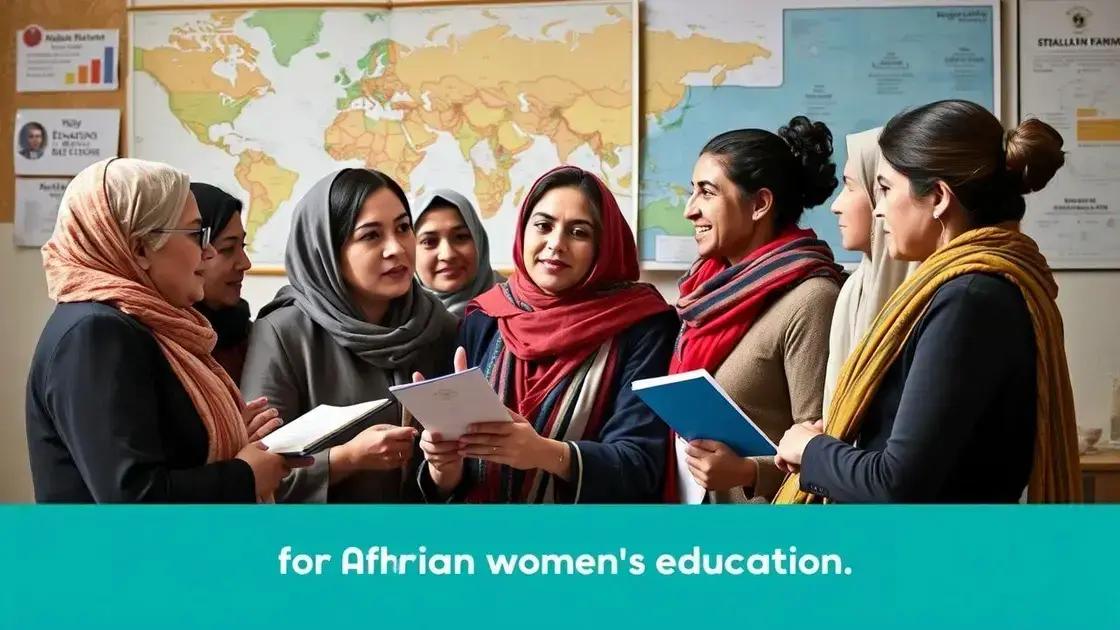Trump cuts educational funding for Afghan women studying abroad

Anúncios
Trump cuts in educational funding for Afghan women studying abroad threaten their access to education and opportunities, highlighting the urgent need for alternative support and global awareness.
Trump cuts educational funding for Afghan women studying abroad, an action that raises questions about support for vulnerable populations. What does this mean for their dreams and future opportunities?
Anúncios
Background of the Afghan women’s education crisis
Understanding the background of the Afghan women’s education crisis is crucial to grasp the challenges these women face. Education is a fundamental right, yet many Afghan women and girls struggle to access basic schooling.
In recent decades, Afghanistan has experienced significant turmoil, which has greatly impacted educational systems. Traditional views on women’s roles often conflict with modern educational aspirations, leaving many young women without the opportunity to learn and grow.
Anúncios
Key factors contributing to the crisis
- Political instability: Continuous conflict in Afghanistan disrupts educational institutions.
- Social norms: Cultural attitudes often discourage female education.
- Lack of resources: Many schools lack basic supplies and qualified teachers, further hindering education.
Despite these obstacles, there are inspiring stories of Afghan women pursuing education against all odds. Many brave individuals have fought for their right to learn and advocate for a brighter future.
Recent developments
The international community has increasingly focused on the education crisis in Afghanistan. Various NGOs are working to provide resources and support to women seeking education, highlighting the dire need for change. These efforts, while impactful, are often met with resistance due to lingering political and cultural challenges.
As we delve deeper into the implications of funding cuts, it is essential to remember the resilience of Afghan women. Their collective strength and determination can become a beacon of hope for future generations aiming for educational equality.
Impact of funding cuts on Afghan women students
The impact of funding cuts on Afghan women students is profound and far-reaching. Losing financial support affects the chances of education for countless young women aiming for a better future.
This situation creates numerous challenges for these students. With reduced funding, many educational institutions struggle to provide even the basic resources for learning. This deprives many girls of the tools they need to succeed.
Consequences of reduced funding
- Limited access to education: Many schools may have to close or limit enrollment, denying opportunities to eager learners.
- Decreased quality of education: With less funding, schools cannot hire qualified teachers or provide necessary materials.
- Greater barriers for marginalized groups: Women from rural areas or low-income families face even tougher challenges in obtaining an education.
The effects of these cuts extend beyond just academic learning. Women who cannot pursue their education may encounter fewer job opportunities, leading to economic consequences. This cycle of poverty continues, making it harder for families to break free from these challenges.
Increased risks and challenges
Alongside educational setbacks, Afghan women students may also face social pressures. As education becomes more inaccessible, cultural stigmas surrounding women’s roles may intensify. This can lead to increased resistance against women pursuing their dreams.
Nevertheless, many Afghan women remain resilient. Despite the challenges, they continue to strive for their education and fight for their rights. Their determination reflects a strong desire for change, not just for themselves, but for future generations of women in Afghanistan.
International response to Trump’s education policy

The international response to Trump’s education policy has stirred a lot of discussion. These changes have prompted reactions not only from government entities but also from various organizations around the world.
Many countries have expressed concern over the implications of cutting funding for educational programs aimed at Afghan women. They see this as a step backward for gender equality and education rights. As more nations voice their opinions, the need for a unified approach becomes clear.
Key reactions from governments
- Condemnation from allies: Various allied countries have criticized the policy, stating it undermines progress made in Afghan women’s education.
- Supportive initiatives: Some nations have announced plans to provide alternative funding to support Afghan women students.
- Calls for reinstatement: Leaders from several countries have urged the U.S. to reconsider these cuts, emphasizing the need for continued investment in education.
Humanitarian organizations have also taken action. They argue that education is fundamental for rebuilding societies. These groups are mobilizing resources to fill the gaps left by funding cuts.
Grassroots movements
Within Afghanistan and beyond, grassroots movements are gaining momentum. Activists advocate for Afghan women’s rights to education, rallying support from around the globe. Their efforts highlight the resilience of Afghan women and the commitment to ensuring that their voices are heard.
The growing international attention also encourages dialogue on education policies. As more stakeholders engage, there is hope for renewed efforts to support Afghan women in their pursuit of education. This collective response could pave the way for a brighter future.
Alternative funding sources for Afghan women
Exploring alternative funding sources for Afghan women is vital in light of recent educational funding cuts. As traditional support diminishes, looking for new ways to enable access to education becomes increasingly important.
Numerous organizations have stepped up, seeking to bridge the gap left by reduced governmental support. These groups focus on providing scholarships and resources to empower Afghan women.
Types of alternative funding
- Non-governmental organizations (NGOs): Many international NGOs actively fund educational projects focused on Afghan women, offering scholarships and materials.
- Crowdfunding platforms: Individuals can support specific causes through websites that enable donations, allowing for grassroots-level support for women’s education.
- Private foundations: Some foundations focus on women’s rights and education, providing grants to programs that support Afghan women’s academic pursuits.
Additionally, partnerships between Afghan institutions and foreign universities can enhance educational opportunities. Such collaborations often provide resources and funding for exchange programs that enable Afghan women to study abroad.
Community-driven initiatives
Within Afghanistan, local initiatives are gaining traction. Community members are working together to fund scholarships and educational materials. These grassroots efforts resonate deeply, as they come from a shared commitment to support future generations of women.
Afghan women are showing remarkable resilience in the face of adversity. By exploring and utilizing these alternative funding sources, they continue to strive for education, which is crucial in shaping their futures.
Future of Afghan women’s education abroad
The future of Afghan women’s education abroad holds both promise and challenges. As changes unfold in educational policies, many Afghan women are still determined to pursue their studies outside the country.
One significant aspect is the increasing awareness about the importance of education for women. Global backing for educational opportunities encourages young women to seek higher learning in foreign institutions.
Opportunities for Afghan women
- Scholarships and exchange programs: Several universities worldwide offer scholarships specifically for Afghan women, aiming to foster inclusivity and diversity.
- International partnerships: Collaborations between Afghan universities and foreign institutions create pathways for students to study abroad.
- Support networks: Many organizations are forming networks to assist Afghan women during their studies, providing mentorship and resources.
Despite the support, challenges remain significant. Afghan women often face barriers, including visa restrictions and cultural differences. These factors can create additional stress for those looking to study abroad. However, their resilience shines through as they navigate these obstacles.
Community and global support
Many communities are rallying behind Afghan women, advocating for their right to education. Global campaigns are raising awareness and promoting the importance of women’s education, spotlighting success stories that inspire others.
The commitment of Afghan women to learn and grow is unwavering. As they seek opportunities for education abroad, the global community’s support plays a crucial role in paving their path to success.
The future of Afghan women’s education is fragile yet filled with potential. As funding cuts challenge their access to education, it highlights the urgent need for support from both local and international communities. While obstacles exist, innovative solutions and strong determination drive the pursuit of education. With scholarships, community initiatives, and global awareness, Afghan women can continue working toward a brighter future. Their resilience and commitment to learning serve as an inspiration for many, showcasing the vital importance of education in shaping lives.
FAQ – Questions about Afghan Women’s Education
What challenges do Afghan women face in accessing education?
Afghan women face numerous challenges, including funding cuts, cultural barriers, and limited resources that restrict their educational opportunities.
How are international organizations supporting Afghan women’s education?
International organizations provide scholarships, resources, and mentoring programs to assist Afghan women in pursuing education abroad.
What alternative funding sources are available for Afghan women’s education?
Alternative funding sources include non-governmental organizations, crowdfunding platforms, and private foundations focused on education and women’s rights.
Why is education essential for Afghan women’s futures?
Education empowers Afghan women, enabling them to gain skills, pursue careers, and contribute to their communities, ultimately fostering societal change and equality.






